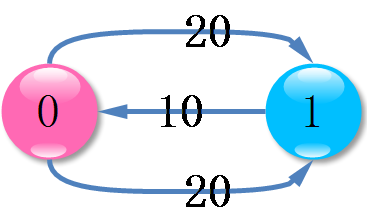![]()

POJ 3068 "Shortest" pair of paths
危险品:N个仓库由M条有向边连接,每条边都有一定费用。将两种危险品从0运到N-1,除了起点和终点外,危险品不能放在一起,也不能走相同的路径。求最小费用?
3.5借助水流解决问题的网络流
最小费用流
除了起点和终点,不能放一起,说明普通顶点的容量都是1,起点终点容量为2。对所有边,追加容量=1;对起点,增加一个源点,建一条容量为2,费用为0的边,连到起点,对终点,增加一个汇点,从终点建一条容量为2,费用0的边到汇点。如图,对于用例:
2 3 0 1 20 0 1 20 1 0 10
原图:

改造为:

这样就得到了一个网络流,在上面跑F=2的最小费用流即可。
#include <iostream>
#include <vector>
#include <queue>
#include <functional>
using namespace std;
#define INF 0x3f3f3f3f
///////////////////////////////最小费用流开始///////////////////////////////////////////
#define MAX_V 64 + 16
typedef pair<int, int> P; // first保存最短距离,second保存顶点编号
//用于表示边的结构体
struct edge
{
int to; // 终点
int cap; // 容量
int cost; // 费用
int rev; // 反向边
edge(int to, int cap, int cost, int rev) :to(to), cap(cap), cost(cost), rev(rev){}
};
int V; // 顶点数
vector<edge> G[MAX_V]; // 图的邻接表
int h[MAX_V]; // 顶点的势
int dist[MAX_V];// 最短距离
int prevv[MAX_V]; // 最短路中的前驱节点
int preve[MAX_V]; // 最短路中的前驱节点对应的边
// 向图中增加一条从from到to的容量为cap费用为cost的边
void add_edge(int from, int to, int cap, int cost)
{
G[from].push_back(edge( to, cap, cost, G[to].size() ));
G[to].push_back(edge(from, 0, -cost, G[from].size() - 1));
}
// 求解从s到t流量为f的最小费用流,如果没有流量为f的流,则返回-1
int min_cost_flow(int s, int t, int f)
{
int res = 0;
memset(h, 0, sizeof(h));
while (f > 0)
{
// 使用Dijkstra算法更新h
priority_queue<P, vector<P>, greater<P> > que;
memset(dist, INF, sizeof(dist));
dist[s] = 0;
que.push(P(0, s));
while (!que.empty())
{
P p = que.top(); que.pop();
int v = p.second;
if (dist[v] < p.first) continue;
for (int i = 0; i < G[v].size(); ++i)
{
edge &e = G[v][i];
if (e.cap > 0 && dist[e.to] > dist[v] + e.cost + h[v] - h[e.to])
{
dist[e.to] = dist[v] + e.cost + h[v] - h[e.to];
prevv[e.to] = v;
preve[e.to] = i;
que.push(P(dist[e.to], e.to));
}
}
}
if (dist[t] == INF)
{
// 不能再增广
return -1;
}
for (int v = 0; v < V; ++v)
{
h[v] += dist[v];
}
// 沿s到t的最短路尽量增广
int d = f;
for (int v = t; v != s; v = prevv[v])
{
d = min(d, G[prevv[v]][preve[v]].cap);
}
f -= d;
res += d * h[t];
for (int v = t; v != s; v = prevv[v])
{
edge &e = G[prevv[v]][preve[v]];
e.cap -= d;
G[v][e.rev].cap += d;
}
}
return res;
}
void clear()
{
for (int i = 0; i < V; ++i)
{
G[i].clear();
}
}
///////////////////////////////最小费用流结束///////////////////////////////////////////
///////////////////////////SubMain//////////////////////////////////
int main(int argc, char *argv[])
{
#ifndef ONLINE_JUDGE
freopen("in.txt", "r", stdin);
freopen("out.txt", "w", stdout);
#endif
int id = 0;
int N, M;
while (scanf("%d%d", &N, &M), N && M)
{
V = N + 2;
add_edge(0, 1, 2, 0);
add_edge(N, N + 1, 2, 0);
for (int i = 0; i < M; ++i)
{
int from, to, cost;
scanf("%d%d%d", &from, &to, &cost);
++from; ++to;
add_edge(from, to, 1, cost);
}
int min_cost = min_cost_flow(0, N + 1, 2);
printf("Instance #%d: ", ++id);
if (min_cost == -1)
{
printf("Not possible\n");
}
else
{
printf("%d\n", min_cost);
}
clear();
}
#ifndef ONLINE_JUDGE
fclose(stdin);
fclose(stdout);
system("out.txt");
#endif
return 0;
}
///////////////////////////End Sub//////////////////////////////////
| 13843179 | hankcs | 3068 | Accepted | 152K | 0MS | C++ | 3054B | 2015-02-01 20:28:30 |
![]() 知识共享署名-非商业性使用-相同方式共享:码农场 » POJ 3068 “Shortest” pair of paths 题解 《挑战程序设计竞赛》
知识共享署名-非商业性使用-相同方式共享:码农场 » POJ 3068 “Shortest” pair of paths 题解 《挑战程序设计竞赛》
 码农场
码农场![[赞] [赞]](http://img.t.sinajs.cn/t35/style/images/common/face/ext/normal/d0/z2_org.gif)